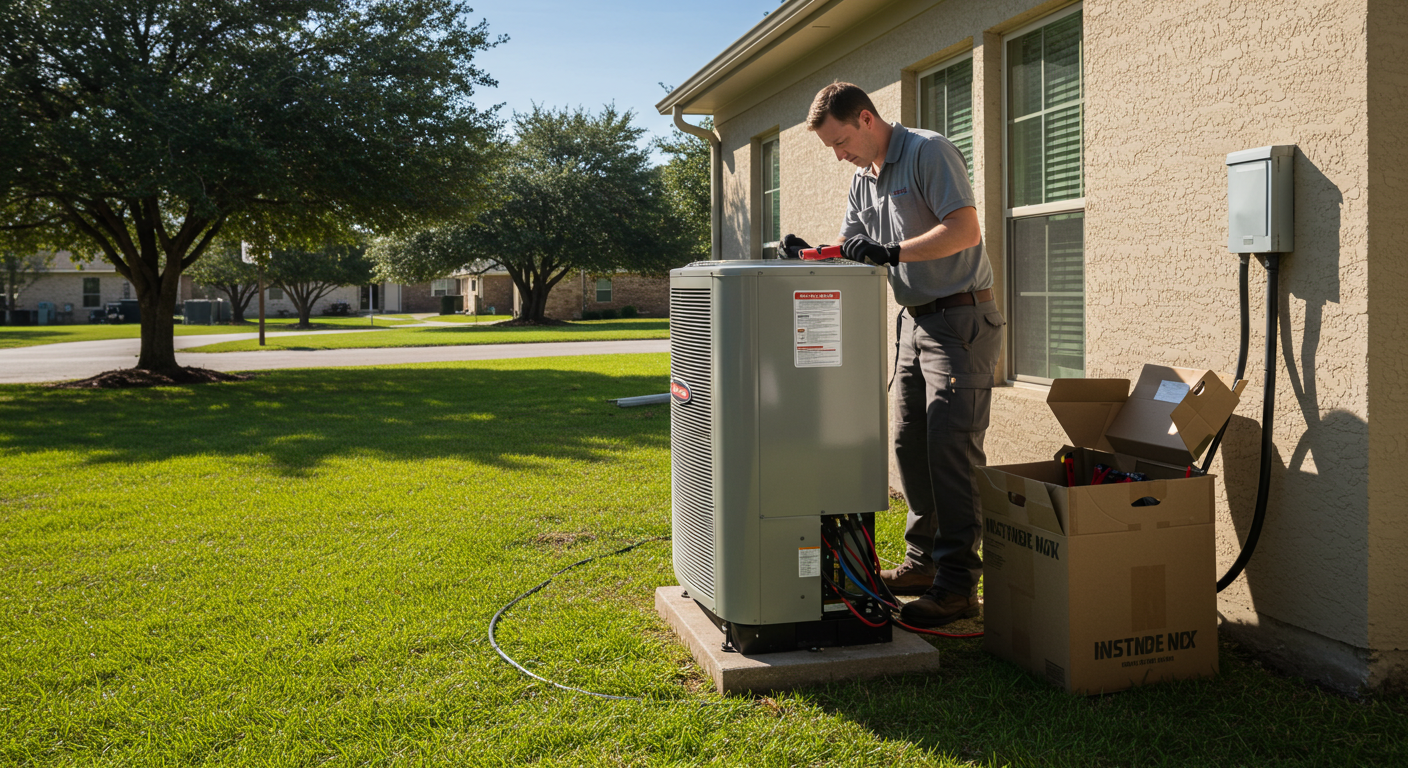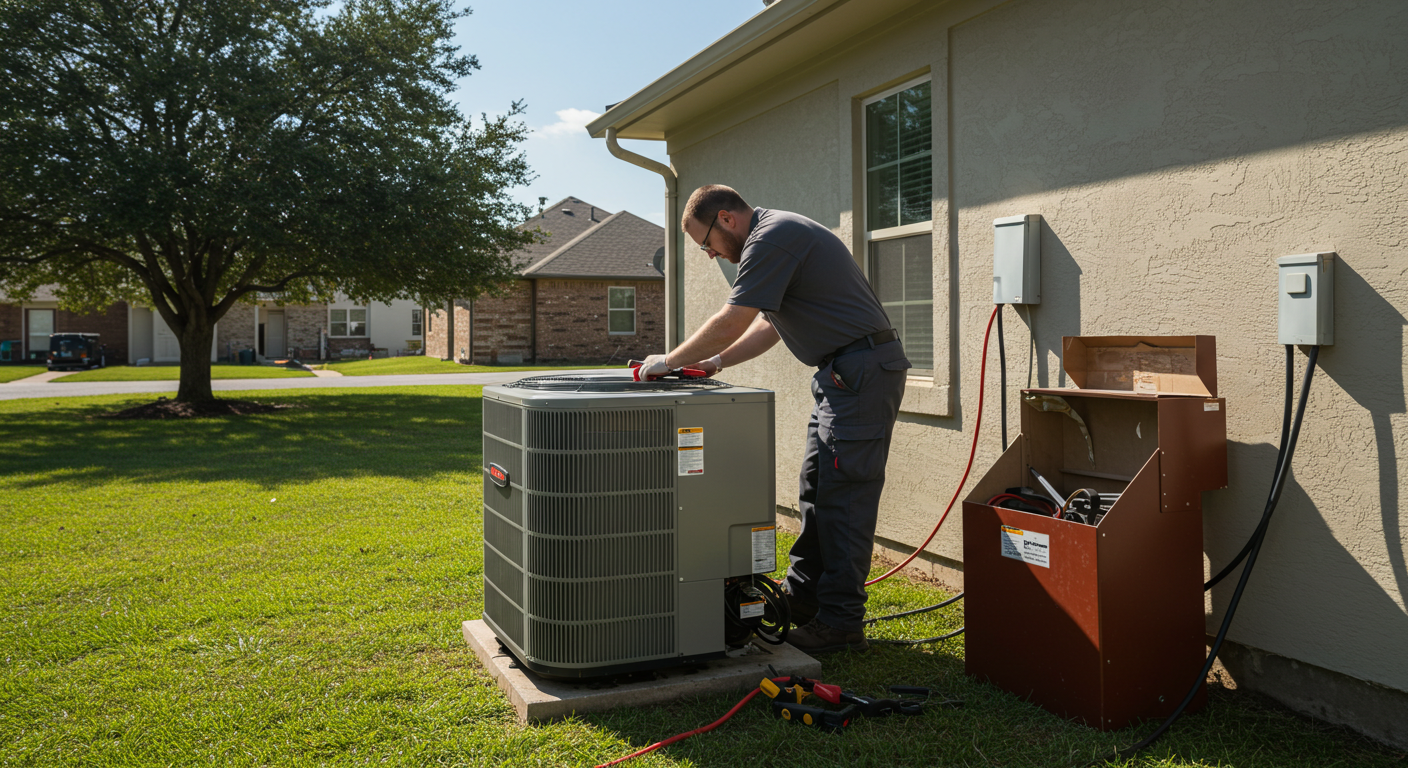Introduction: Why More Texas Homeowners Are Choosing Heat Pumps
If you’ve spent a summer in Texas, you know how brutal the heat can get, and if you’ve been through one of those unexpected cold snaps, you also know how quickly temperatures can swing. That’s why so many homeowners are turning to heat pump installation as their all-in-one comfort solution. A heat pump doesn’t just cool your home in summer, it also keeps it warm in winter, and it does it all more efficiently than most traditional systems.
At Shellaby A/C & Refrigeration, we’ve helped hundreds of Texans upgrade to systems that save them money, keep them comfortable, and reduce the headaches that come with older HVAC setups. This guide will walk you through everything from central air heat pump installation to heat pump installation requirements so you can make the right decision for your home and budget.
Thinking about making the switch? Keep reading. By the end of this guide, you’ll know exactly what type of heat pump is right for you, how much it will cost, and how to get it installed the right way the first time.

1. Understanding How Heat Pumps Work — Without the Technical Overload
A heat pump works by moving heat rather than generating it. In summer, it pulls heat out of your home and sends it outdoors. In winter, it works in reverse, pulling heat from the outside air and bringing it inside. Even when it’s chilly outside, there’s still enough heat in the air for the pump to move indoors.
For Texas homeowners, this means you can replace both your air conditioner and furnace with one system that keeps your home at a comfortable temperature year-round. If you’ve ever wondered whether residential heat pump installation is worth it in our climate, the answer is a big yes.
Considering the upgrade? A quick consultation with a local pro can help you avoid costly mistakes and choose the right model for your home.
2. Why Heat Pump Installation Makes Sense in Texas
2.1 Handles Texas Weather Fluctuations
Our summers are scorching, but winters can surprise you. A heat pump adapts to both extremes without needing two separate systems.
2.2 Saves on Energy Bills
Because a heat pump moves heat instead of creating it, it uses far less energy than a furnace or electric heater. That means lower utility bills are a big deal when Texas summer air conditioning costs can skyrocket.
2.3 Works in New or Existing Homes
Whether you’re building new or installing a heat pump in an existing home, the right system can be tailored to your needs.
2.4 Qualifies for Rebates and Incentives
Texas utility companies often offer rebates for electric heat pump installation, which helps offset the initial cost.
Lower bills, year-round comfort, and local rebates, it’s no wonder Texans are making the switch.
3. Choosing the Right Heat Pump for Your Home
No two homes are alike, and choosing the wrong system is one of the most common mistakes homeowners make. Here are the main options:
3.1 Central Air Heat Pump Installation
Great for homes with existing ductwork. Delivers even air distribution and works well for larger homes.
3.2 Air Heat Pump Installation
A straightforward choice for standard heating and cooling needs without complex zoning requirements.
3.3 Ductless Mini-Splits
Ideal for homes without ductwork or for adding climate control to specific rooms like garages, workshops, or home additions.
Not sure which one is right for you? A quick home evaluation can point you in the right direction.
4. Heat Pump Installation Requirements in Texas
Before you book your installation, it’s important to know what’s needed to get the job done right:
- Proper Sizing – A unit that’s too small will struggle to heat or cool, while one that’s too large will cycle on and off too often, wasting energy.
- Electrical Capacity – An electric heat pump installation might require an upgraded breaker panel if your current one can’t handle the load.
- Permits and Inspections – Most Texas cities require permits for heat pump system installation. A professional installer will handle this for you.
- Professional Installation – Learning how to connect heat pump wiring from YouTube isn’t enough; an experienced tech ensures safety, efficiency, and warranty protection.
The smoother your installation process, the faster you’ll start enjoying better comfort and lower bills.
5. The Heat Pump Installation Process — Step-by-Step
When you work with a professional team like Shellaby A/C & Refrigeration, here’s what you can expect:
- Initial Consultation & Home Assessment – We measure your home, check insulation, and talk about your comfort needs.
- System Selection – Based on your budget and goals, we recommend the right heat pump system installation.
- Preparing the Site – Clearing outdoor space for the unit, checking ductwork, and making any needed electrical adjustments.
- Outdoor Unit Installation – This is the main hub that moves heat in and out of your home.
- Indoor Unit Setup – This could be a ducted air handler or wall-mounted mini-split head, depending on your system type.
- Refrigerant & Electrical Connections – Our technicians know exactly how to fit a heat pump and ensure safe wiring and line connections.
- Testing & Calibration – We run the system in both heating and cooling modes to confirm it’s working efficiently.
- Walkthrough & Tips – Before leaving, we explain how to operate and maintain your new heat pump for maximum lifespan.
By understanding the process, you can avoid confusion and make sure your installer is doing the job right.

6. Cost of Heat Pump Installation in Texas
The price of installing a heat pump in an existing home varies, but most Texas homeowners spend between $4,000 and $8,000.
Factors that affect cost:
- Type of heat pump (central, ductless, or hybrid)
- Home size and insulation quality
- Electrical upgrades for electric heat pump installation
- Brand and efficiency rating
- Labor rates in your area
Remember, the cheapest system isn’t always the best value. Paying a little more upfront can mean lower bills, fewer repairs, and a system that lasts years longer.
7. Benefits That Go Beyond Heating and Cooling
- Lower Utility Bills – Energy efficiency means real savings every month.
- Better Air Quality – Heat pumps filter and circulate air, reducing dust, pollen, and allergens.
- Consistent Comfort – No more hot spots in summer or chilly corners in winter.
- Quiet Operation – Modern systems run much quieter than older HVAC units.
When you add up all these benefits, a heat pump isn’t just a purchase; it’s a long-term investment in your home’s comfort.
8. Avoid These Common Installation Mistakes
- Going for the cheapest installer without checking experience.
- Attempting DIY even if you’ve read guides on how to fit a heat pump, small mistakes can void warranties.
- Ignoring maintenance can shorten system lifespan and reduce efficiency.
Avoiding these pitfalls could save you thousands over the life of your system.
9. Keeping Your Heat Pump in Top Shape
- Change filters regularly (every 1–3 months).
- Schedule professional maintenance at least once a year.
- Keep outdoor units free from leaves, grass, and debris.
A well-maintained heat pump will last longer, run more efficiently, and give you fewer repair headaches.
10. Choosing the Right Installer in Texas
When hiring someone for residential heat pump installation, make sure they:
- We are licensed and insured in Texas.
- Have experience with central air heat pump installation and air heat pump installation.
- Provide clear, upfront pricing.
- Offer a warranty on both parts and labor.

Shellaby A/C & Refrigeration has a long history of helping Texans upgrade their comfort systems. We handle everything from explaining heat pump installation requirements to showing you how to connect heat pump controls for maximum efficiency.
Ready to get started? A simple call today can put you on the path to a more comfortable, energy-efficient home.
Conclusion: Ready to Upgrade?
Switching to a heat pump isn’t just about new equipment; it’s about improving the comfort, efficiency, and value of your home. Whether you’re building new or installing a heat pump in an existing home, the right system will make a noticeable difference in your day-to-day life.
If you’re in Texas and ready to make the change, Shellaby A/C & Refrigeration is here to walk you through every step. From selecting the right unit to professional installation and ongoing service, we make the process simple and stress-free.
Don’t wait until the next heatwave or cold snap. Schedule your consultation today and take the first step toward better comfort and lower energy bills.
